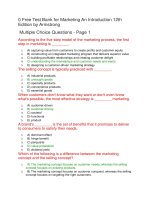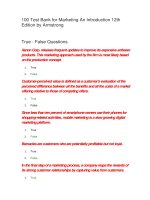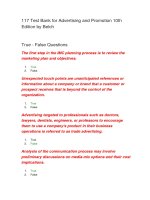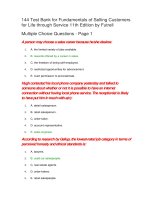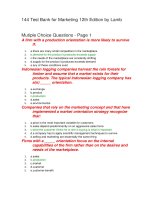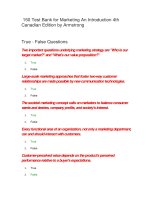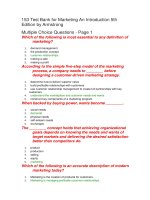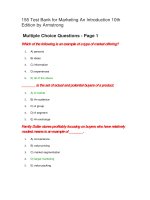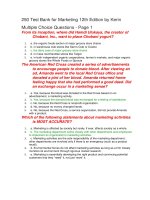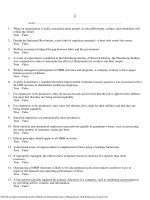100 test bank for marketing an introduction 12th edition by armstrong đề trắc nghiệm marketing
Bạn đang xem bản rút gọn của tài liệu. Xem và tải ngay bản đầy đủ của tài liệu tại đây (144.19 KB, 30 trang )
100 Test Bank for Marketing An Introduction 12th
Edition by Armstrong
True - False Questions
Xenon Corp. releases frequent updates to improve its expensive software
products. This marketing approach used by the firm is most likely based
on the production concept.
1.
True
2.
False
Customer-perceived value is defined as a customer's evaluation of the
perceived difference between all the benefits and all the costs of a market
offering relative to those of competing offers.
1.
True
2.
False
Since less than ten percent of smartphone owners use their phones for
shopping-related activities, mobile marketing is a slow growing digital
marketing platform.
1.
True
2.
False
Barnacles are customers who are potentially profitable but not loyal.
1.
True
2.
False
In the final step of a marketing process, a company reaps the rewards of
its strong customer relationships by capturing value from customers.
1.
True
2.
False
Market offerings include entities such as people, places, information, and
ideas.
1.
True
2.
False
Through consumer-generated marketing, consumers themselves are
playing a bigger role in shaping their own brand experiences and those of
others.
1.
True
2.
False
The product concept holds that consumers will favor products that offer
the most in quality, performance, and innovative features.
1.
True
2.
False
Product, price, place, and promotion make up the elements of a firm's
marketing mix.
1.
True
2.
False
Customer equity is a measure of the past value of a company's customer
base.
1.
True
2.
False
Organizations that follow the societal marketing concept most likely
practice socially and environmentally responsible marketing.
1.
True
2.
False
The process of dividing the market into segments of customers is known
as market penetration.
1.
True
2.
False
After the Great Recession, marketers have started focusing on value-forthe-money, practicality, and durability in their product offerings and
marketing pitches.
1.
True
2.
False
When sellers pay less attention to the specific products they offer and
more attention to the benefits and experiences produced by these
products, they suffer from marketing myopia.
1.
True
2.
False
A market is a segment of potential consumers who share a common need
or want.
1.
True
2.
False
In markets with few customers and high margins, sellers should try to
develop basic relationships rather than full partnerships.
1.
True
2.
False
Customer-driving companies create products and services that serve only
the existing needs of consumers.
1.
True
2.
False
When backed by buying power, wants become needs.
1.
True
2.
False
The more loyal a firm's profitable customers, the lower its customer
equity.
1.
True
2.
False
Success at delivering customer value rests on how well a company's
entire supply chain performs against competitors' supply chains.
1.
True
2.
False
A brand's value proposition is the set of benefits or values it promises to
deliver to consumers to satisfy their needs.
1.
True
2.
False
Marketing is managing profitable customer relationships.
1.
True
2.
False
Club marketing programs reward customers who buy frequently or in
large amounts.
1.
True
2.
False
A greater focus on underlying customer needs than on existing customer
wants leads to marketing myopia.
1.
True
2.
False
Customer relationship management focuses on retaining existing
customers but not on acquiring new customers.
1.
True
2.
False
Multiple Choice Questions - Page 1
The ________ concept holds that achieving organizational goals depends
on knowing the needs and wants of target markets and delivering the
desired satisfactions better than competitors do.
1.
A) marketing
2.
B) product
3.
C) production
4.
D) selling
5.
E) societal marketing
According to the product concept, a company should ________.
1.
A) make products that contribute to the long-term welfare of society
2.
B) market only those products that have high customer appeal
3.
C) focus on a target market and make products that meet those customers'
demands
4.
D) devote its energy to making continuous product improvements
5.
E) make product promotion a top priority
A brand's ________ is the set of benefits that it promises to deliver to
consumers to satisfy their needs.
1.
A) dominant effect
2.
B) fringe benefit
3.
C) perquisite
4.
D) value proposition
5.
E) dividend yield
Marketers are said to suffer from marketing myopia when they ignore
underlying consumer needs and focus excessively on ________.
1.
A) consumers' brand experiences
2.
B) competitors' threats
3.
C) consumers' existing wants
4.
D) competitors' strengths
5.
E) consumers' future demands
________ are the form human needs take as they are shaped by culture
and individual personality.
1.
A) Wants
2.
B) Necessities
3.
C) Services
4.
D) Benefits
5.
E) Risks
Voize, a leading mobile phone manufacturer, focuses on low labor costs
and mass distribution to ensure the continuous availability of its products
at reasonable prices. Voize most likely follows the ________.
1.
A) customer-driving marketing concept
2.
B) marketing concept
3.
C) societal marketing concept
4.
D) production concept
5.
E) selling concept
________ is the act of obtaining a desired object from someone by
offering something in return.
1.
A) Targeting
2.
B) Segmentation
3.
C) Differentiation
4.
D) Exchange
5.
E) Positioning
Which of the following is a difference between the marketing concept and
the selling concept?
1.
A) The marketing concept focuses on customer needs, whereas the selling
concept focuses on existing products.
2.
B) The marketing concept focuses on customer conquest, whereas the selling
concept focuses on targeting the right customers.
3.
C) The marketing concept takes an inside-out perspective, whereas the selling
concept takes an outside-in perspective.
4.
D) The marketing concept is product-centered, whereas the selling concept is
production-centered.
5.
E) The marketing concept focuses on short-term sales, whereas the selling
concept strives to build long-term customer relationships.
Futuristic Designs Inc., a furniture retail chain, understands and
anticipates customer needs even better than customers themselves do
and creates products and services to meet their existing and future needs.
Which of the following has Futuristic Designs followed in this case?
1.
A) the product concept
2.
B) customer-driving marketing
3.
C) the societal marketing concept
4.
D) customer-driven marketing
5.
E) the production concept
Customer-driven marketing is most effective when ________.
1.
A) a clear need exists among customers, but the need is difficult to identify
2.
B) customers do not know what they want but are easily persuaded
3.
C) customers seek new products and technological innovations
4.
D) clear needs exist and customers know what their needs are
5.
E) customers have wants but cannot afford them
The ________ concept holds that consumers will favor goods and
services that offer the most in quality, performance, and innovative
features.
1.
A) societal marketing
2.
B) marketing
3.
C) selling
4.
D) production
5.
E) product
The selling concept is typically practiced with ________.
1.
A) industrial products
2.
B) unsought goods
3.
C) specialty products
4.
D) convenience products
5.
E) essential goods
When backed by buying power, wants become ________.
1.
A) needs
2.
B) demands
3.
C) offerings
4.
D) values
5.
E) ideas
________ are defined as states of felt deprivation.
1.
A) Needs
2.
B) Ideas
3.
C) Demands
4.
D) Values
5.
E) Exchanges
Abel now has the buying power to purchase the computer that he wanted
to buy six months ago. Abel's want has most likely become a(n) ________.
1.
A) need
2.
B) value
3.
C) demand
4.
D) offering
5.
E) desire
Which of the following concepts is based on a customer-centered
philosophy?
1.
A) the product concept
2.
B) the marketing concept
3.
C) the production concept
4.
D) the selling concept
5.
E) the distribution concept
The societal marketing concept holds that ________.
1.
A) consumers will not buy enough of a firm's products unless the firm undertakes a
large-scale selling and promotion effort
2.
B) a company's marketing decisions should focus on creating economic value in a
way that also creates value for the surrounding environment
3.
4.
C) the society will only favor products that are available and highly affordable
D) achieving organizational goals depends on knowing the needs and wants of
target markets and delivering the desired satisfactions better than competitors do
5.
E) consumers will favor products that offer the most in quality, performance, and
innovative features
Henry Ford's philosophy was to perfect the Model-T so that its cost could
be reduced further for increased consumer affordability. This most likely
reflects the ________.
1.
A) customer-driving marketing concept
2.
B) marketing concept
3.
C) societal marketing concept
4.
D) production concept
5.
E) selling concept
Cylog, a leading provider of personal computer systems, began
manufacturing tablet devices after predicting a future consumer need for
portability. Which of the following was most likely implemented by Cylog?
1.
A) the selling concept
2.
B) customer-driving marketing
3.
C) the product concept
4.
D) sustainable marketing
5.
E) the production concept
Dividing a market into several sections of customers is known as
________.
1.
A) mass customization
2.
B) market positioning
3.
C) market segmentation
4.
D) value engineering
5.
E) undifferentiated marketing
The production concept holds that ________.
1.
A) consumers will not buy enough of a firm's products unless the firm undertakes a
large-scale selling and promotion effort
2.
B) a company's marketing decisions should consider consumers' wants, the
company's requirements, consumers' long-run interests, and society's long-run
interests
3.
C) consumers will favor products that are available and highly affordable
4.
D) achieving organizational goals depends on knowing the needs and wants of
target markets and delivering the desired satisfactions better than competitors do
5.
E) consumers will favor products that offer the most in quality, performance, and
innovative features
Selecting particular segments of a population of customers to serve is
called ________.
1.
A) process reengineering
2.
B) brand synchronizing
3.
C) mass customizing
4.
D) target marketing
5.
E) market positioning
Which of the following concepts holds that consumers will favor products
that are available and highly affordable?
1.
A) the marketing concept
2.
B) the product concept
3.
C) the societal marketing concept
4.
D) the selling concept
5.
E) the production concept
The selling concept holds that ________.
1.
A) consumers will not buy enough of a firm's products unless the firm undertakes
large-scale persuasion and promotion efforts
2.
B) a company's marketing decisions should consider consumers' wants, the
company's requirements, consumers' long-run interests, and society's long-run
interests
3.
C) consumers will only favor products that are available and highly affordable
4.
D) achieving organizational goals depends on knowing the needs and wants of
target markets and delivering the desired satisfactions better than competitors do
5.
E) consumers will favor products that offer the most in quality, performance, and
innovative features
When customers don't know what they want or don't even know what's
possible, the most effective strategy is ________ marketing.
1.
A) customer-driven
2.
B) customer-driving
3.
C) societal
4.
D) functional
5.
E) product
GT Grand, a manufacturer of ultra-luxury cars, supplies customized
vehicles based on the specific demands of customers in affluent market
segments. The company's approach is most likely referred to as
________.
1.
A) mass distribution
2.
B) cost leadership
3.
C) consumer-generated marketing
4.
D) target marketing
5.
E) undifferentiated marketing
Directing consumers toward products and services that meet their present
and future needs is referred to as ________ marketing.
1.
A) customer-driven
2.
B) customer-driving
3.
C) societal
4.
D) production
5.
E) product
Which of the following concepts calls for sustainable marketing?
1.
A) the societal marketing concept
2.
B) the marketing concept
3.
C) the selling concept
4.
D) the production concept
5.
E) the product concept
According to the five-step model of the marketing process, the first step in
marketing is ________.
1.
A) capturing value from customers to create profits and customer equity
2.
B) constructing an integrated marketing program that delivers superior value
3.
C) building profitable relationships and creating customer delight
4.
D) understanding the marketplace and customer needs and wants
5.
E) designing a customer-driven marketing strategy
60 Free Test Bank for Marketing An Introduction 12th
Edition by Armstrong Multiple Choice Questions Page 2
In which of the following circumstances is an organization likely to
engage in full partnerships with key consumers?
1.
A) when the market has few customers and high margins
2.
B) when the market has a huge number of customers
3.
C) when the firm has a frequency marketing program
4.
D) when the firm has a large number of low-margin customers
5.
E) when the firm has few marketing resources at its disposal
________ are customers who show low potential profitability and little
projected loyalty.
1.
A) True friends
2.
B) Barnacles
3.
C) Strangers
4.
D) True believers
5.
E) Butterflies
The overall process of dealing with all aspects of acquiring, keeping, and
growing customers is referred to as ________.
1.
A) perceived-value management
2.
B) societal marketing
3.
C) customer relationship management
4.
D) partner relationship management
5.
E) enterprise resource planning
In which of the following customer relationship groups do organizations
generally avoid investing?
1.
A) barnacles
2.
B) strangers
3.
C) butterflies
4.
D) true believers
5.
E) true friends
________ refers to a channel stretching from raw materials to components
to final products that are carried to final buyers.
1.
A) A supply chain
2.
B) A marketing channel
3.
C) A market segment
4.
D) A demand chain
5.
E) A marketing-mix channel
Customers who are classified as true believers ________.
1.
A) are attracted to a company's competitor's deals and offers
2.
B) have needs and wants that do not fit a company's offerings
3.
C) are not very profitable for a company
4.
D) tell others about their good experiences with a company
5.
E) are projected to be less loyal to any brand
Some fast food restaurants offer tasty and convenient food at affordable
prices, but in doing so they contribute to the soaring obesity rates and
environmental problems. In this case, these fast-food restaurants have
overlooked the ________ concept.
1.
A) marketing
2.
B) product
3.
C) production
4.
D) societal marketing
5.
E) selling
________ refers to the portion of the customer's purchase that a company
gets in its product categories.
1.
A) Value proposition
2.
B) Share of customer
3.
C) Brand equity
4.
D) Customer lifetime value
5.
E) Customer equity
Which of the following terms refers to a customer's evaluation of the
difference between all the benefits and all the costs of a market offering
relative to those of competing offers?
1.
A) customer-perceived value
2.
B) customer equity
3.
C) share of customer
4.
D) customer profitability
5.
E) customer lifetime value
The state department of health has allotted a significant amount of money
for an advertising campaign that emphasizes the ill effects of smoking and
spans radio, print, television, and online media. This is an example of
________ marketing.
1.
A) ambush
2.
B) social
3.
C) for-profit
4.
D) consumer-generated
5.
E) multi-level
Which of the following is most likely a consequence of the Great
Recession of 2008 to 2009?
1.
A) more free-spending on expensive products
2.
B) more demand for credit and debit cards
3.
C) more sensible and mindful consumption
4.
D) less interest in frugality and value
5.
E) less emphasis on sustainable marketing
Which of the following transforms marketing strategies into real values for
consumers?
1.
A) share of customer
2.
B) customer equity
3.
C) the four Ps of marketing
4.
D) a firm's value proposition
5.
E) customer satisfaction surveys
At Ken's boutique, the policy statement posted in the reception states:
"Without our customers, we don't exist." Ken and his staff aim to delight
each customer and they are quick to offer discounts or extra services
whenever a customer is anything less than satisfied. Instead of focusing
on individual transactions, Ken and his staff are putting a priority on
________.
1.
A) decreasing customer-perceived value
2.
B) managing partner relationships
3.
C) attracting "butterflies"
4.
D) converting "strangers" into "butterflies"
5.
E) capturing customer lifetime value
________ marketing is defined as socially and environmentally
responsible marketing that meets the present needs of consumers and
businesses while also preserving or enhancing the ability of future
generations to meet their needs.
1.
A) Customer-driven
2.
B) Mass
3.
C) Sustainable
4.
D) Customer-driving
5.
E) Ambush
Ellis, a marketing manager at a regional chain restaurant, has decided to
create a contest asking the public to create commercials for the
restaurant. Winning entries will be posted on the organization's home
page. Ellis' plan is an example of ________.
1.
A) consumer-generated marketing
2.
B) frequency marketing
3.
C) customer-club marketing
4.
D) sustainable marketing
5.
E) multi-level marketing
Customer evangelists are those who ________.
1.
A) use personal selling methods to market products and services
2.
B) tell others about their good experiences with a brand or product
3.
C) use their expertise to influence people about specific products
4.
D) work with quality-assurance teams to improve product safety
5.
E) evaluate newly launched products in the marketplace
Which of the following is an example of consumer-generated marketing?
1.
A) Cristal, a jewelry store, uses its page on Facebook to provide information about
its upcoming products to its customers.
2.
B) Figa, a leading provider of athletic shoes, helps its customers customize their
shoes on its Web site and choose personalized settings.
3.
C) Fun & Run, a local amusement park, promotes its services by allowing
consumers to upload videos and write reviews about the park.
4.
D) Barton's, a local pet supply store, rewards frequent buyers with vouchers and
exclusive offers.
5.
E) Energix, a manufacturer of soft drinks, attracts customers through televised
advertisements.
Fine Corp., a consumer electronics manufacturer, targets a market with
many low-margin customers. Which of the following types of associations
would be most profitable for the firm to develop with these customers?
1.
A) full partnerships
2.
B) basic relationships
3.
C) joint ventures
4.
D) strategic alliances
5.
E) business partnering
A customer who is both loyal and profitable is referred to as a ________.
1.
A) barnacle
2.
B) stranger
3.
C) true believer
4.
D) laggard
5.
E) butterfly
The Niketown running community organizes bimonthly athletic training
programs for Nike buyers. This is an example of a ________.
1.
A) business partnership program
2.
B) joint venture
3.
C) club marketing program
4.
D) consumer-generated marketing program
5.
E) strategic alliance
The concept of shared value focuses on ________.
1.
A) creating economic value in a way that also creates value for society
2.
B) maximizing profits to satisfy shareholders
3.
C) creating sales transactions instead of long-term customer relationships
4.
D) building strategic supplier partnerships to create more value for investors
5.
E) providing more financial incentives to sales team members
________ is the total combined customer lifetime values of all the
company's current and potential customers.
1.
A) Share of customer
2.
B) Value proposition
3.
C) Customer equity
4.
D) Market share
5.
E) Customer-perceived value
Greater consumer control means that companies must rely more on
marketing by ________.
1.
A) intrusion
2.
B) attraction
3.
C) competition
4.
D) forceful persuasion
5.
E) impersonal selling
Which of the following is true of mobile marketing?
1.
A) Few American adults today own a smartphone.
2.
B) A smartphone is a highly impersonal medium with a low scope for engagement.
3.
C) Marketers use mobile channels to stimulate immediate buying.
4.
D) Mobile marketing is a traditional marketing method.
5.
E) Mobile marketing is the slowest-growing digital marketing platform.
The ultimate aim of customer relationship management is to ________.
1.
A) produce high customer equity
2.
B) divide markets into distinct segments
3.
C) evaluate customer lifetime value
4.
D) turn "strangers" into "butterflies"
5.
E) evaluate current sales share
Raymond purchased a Honda Civic six months ago because he perceived
Honda's superiority over the competition. Raymond has been more than
satisfied with his purchase and now has an emotional relationship with
the Honda brand. Raymond's relationship with Honda is best referred to
as ________.
1.
A) customer delight
2.
B) customer lifetime value
3.
C) customer equity
4.
D) customer share
5.
E) customer-perceived value
A consumer who is potentially profitable but shifts loyalty toward better
deals is referred to as a ________.
1.
A) true friend
2.
B) butterfly
3.
C) stranger
4.
D) barnacle
5.
E) true believer
Carla, a team leader in charge of customer relationship management, is
planning strategies to improve the profitability of her firm's least profitable
but loyal customers. She is also examining methods for "firing"
customers in this group who cannot be made profitable. To which of the
following customer relationship groups do these customers belong?
1.
A) butterflies
2.
B) true friends
3.
C) strangers
4.
D) barnacles
5.
E) innovators
Sally purchased a newly introduced moisturizing lotion. By attempting to
find out if the lotion's perceived performance matched her expectations,
Sally was measuring her level of customer ________.
1.
A) loyalty
2.
B) satisfaction
3.
C) equity
4.
D) engagement
5.
E) lifetime value
________ refers to working closely with people inside and outside the
company to jointly bring more value to customers.
1.
A) Demand management
2.
B) Customer-generated marketing
3.
C) Integrated communication
4.
D) Partner relationship management
5.
E) Channel value proposition
The final step in the marketing process is ________.
1.
A) capturing value from customers
2.
B) constructing an integrated marketing program
3.
C) building profitable relationships with the customers
4.
D) understanding the marketplace
5.
E) designing a customer-driven marketing strategy
Free Text Questions
Compare and contrast the product and production concepts.
Answer Given
The production concept holds that consumers will favor products that are available
and highly affordable. Therefore, it dictates that management should focus on
improving production and distribution efficiency. This concept is one of the oldest
orientations that guides sellers. The production concept is still a useful philosophy
in some situations. For example, both personal computer maker Lenovo and
home appliance maker Haier dominate the highly competitive, price-sensitive
Chinese market through low labor costs, high production efficiency, and mass
distribution. However, although useful in some situations, the production concept
can lead to marketing myopia. Companies adopting this orientation run a major
risk of focusing too narrowly on their own operations and losing sight of the real
objective–satisfying customer needs and building customer relationships. The
product concept holds that consumers will favor products that offer the most in
quality, performance, and innovative features. Under this concept, marketing
strategy focuses on making continuous product improvements. Product quality
and improvement are important parts of most marketing strategies. However,
focusing only on products can also lead to marketing myopia. For example,
manufacturers of mouse traps might believe that if they can build a better
mousetrap, their profits will soar. But they are often rudely shocked. Buyers may
be looking for a better solution to a mouse problem but not necessarily for a better
mousetrap. The better solution might be a chemical spray, an exterminating
service, a house cat, or something else that suits their needs even better than a
mousetrap. Furthermore, a better mousetrap will not sell unless the manufacturer
designs, packages, and prices it attractively, places it in convenient distribution
channels, brings it to the attention of people who need it, and convinces buyers
that it is a better product.
Define customer-perceived value.
Answer Given
Customer-perceived value is defined as the customer's evaluation of the
difference between all the benefits and all the costs of a market offering relative to
those of competing offers. Importantly, customers often do not judge values and
costs accurately or objectively. They act on perceived value. A customer buys
from the firm that offers the highest customer-perceived value.
The aim of customer relationship management is to create not just
customer satisfaction, but customer delight as well. Explain.
Answer Given
Customer satisfaction cannot be taken for granted. Since brand loyalty is
dependent upon strong customer satisfaction, companies strive to retain, satisfy,
and even delight current customers. Firms create customer delight by promising
only what they can deliver and then delivering more than what they promise. They
also create emotional relationships with key customers. Delighted customers
make repeated purchases and become customers for life. More importantly, they
also essentially become an unpaid sales force for the firm as "customer
evangelists" who tell other potential customers about their positive experiences
with a product.
Compare and contrast customer-managed relationships and consumergenerated marketing.
Answer Given
Today's consumers have more information about brands than ever before, and
they have a wealth of platforms for airing and sharing their brand views with other
consumers. Thus, the marketing world is now embracing not only customer
relationship management, but also customer-managed relationships. Greater
consumer control means that companies can no longer rely on marketing by
intrusion. Instead, marketers must practice marketing by attraction–creating
market offerings and messages that involve consumers rather than interrupt them.
Hence, most marketers now augment their mass-media marketing efforts with a
rich mix of direct marketing approaches that promote brand—consumer
interaction. For example, many brands are creating dialogues with consumers via
their own or existing online social networks. A growing part of the new customer
dialogue is consumer-generated marketing, by which consumers themselves are
playing a bigger role in shaping their own brand experiences and those of others.
This might happen through uninvited consumer-to-consumer exchanges in blogs,
video-sharing sites, and other digital forums. Increasingly, companies are also
inviting consumers to play a more active role in shaping products and brand
messages. One drawback of this process is that harnessing consumer-generated
content can be time-consuming and expensive.
Compare the selling and marketing concepts, and list the key components
of each concept.
Answer Given
